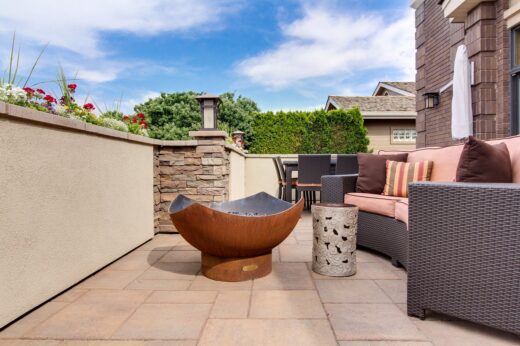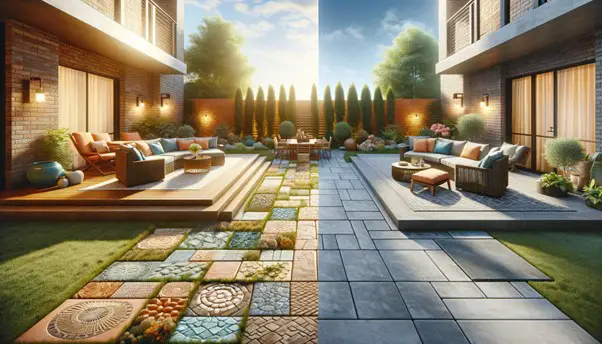How to pour a concrete patio guide, American home terrrace design tips, North Carolina property landscape advice
Comparing Concrete versus Paver Patios
March 29, 2024
Comparing Concrete vs. Paver Patios: Choosing the Right Material for Your Fayetteville Property
When it comes to designing the perfect outdoor space for your Fayetteville property, choosing the right material for your patio is an essential aspect of the process. Two popular options that homeowners tend to consider are concrete and paver patios. Both materials have their unique advantages and drawbacks, making it crucial to weigh their features before determining the ideal choice for your specific needs.
Concrete patios, known for their durability and affordability, are an excellent option for those looking for a low-maintenance and cost-effective solution. With concrete installation services readily available, homeowners can customize their patios through various techniques such as stamping and staining, giving them a personalized and attractive appearance.
On the other hand, paver patios offer an upscale, elegant look and provide a high degree of customization with their vast array of shapes, sizes, and colors. Additionally, paver patios boast longevity and a flexible design, making them a worthwhile investment for homeowners seeking a refined outdoor living space.
Material Insights: Concrete vs. Paver Patios
Concrete Patio Pros and Cons
Concrete is a popular choice for patio surfaces due to its cost-effectiveness, which ranges from $8 to $15 per square foot after installation. It offers design versatility, as it can be customized with colors and textures. One popular design option is stamped concrete, which can mimic other materials like brick or stone.
However, concrete does have some drawbacks. It may develop cracks over time, especially in areas with fluctuating temperatures, and repairs can be challenging. Additionally, the overall aesthetic appeal might be considered less sophisticated compared to pavers.
Paver Patio Advantages and Disadvantages
Paver patios are made of individual brick, stone, or concrete units laid out in various patterns, such as herringbone, to create a visually appealing surface. Some popular materials for paver patios include travertine and flagstone. Pavers, which typically have a strength of 8,000 PSI or greater, tend to be more durable and long-lasting compared to poured concrete. They also offer better adaptability, as they can easily be modified or replaced if needed.
However, paver patios are typically more expensive and labor-intensive compared to concrete, costing between $10 to $50 per square foot. Installation requires proper preparation and additional binding agents, which can increase costs.
Assessing Durability and Longevity
When considering durability, pavers have an edge over concrete. Poured concrete has a PSI (pounds per square inch) strength of around 3,000 to 4,000, whereas pavers provide more than double that amount. This increased strength makes pavers more resistant to cracking and weather-related damage.
Furthermore, pavers are less likely to experience long-term wear and tear, as damaged or worn sections can easily be replaced without impacting the entire patio. On the other hand, cracked or damaged concrete may require extensive repairs or even complete replacement.
Design Versatility and Aesthetic Appeal
Both concrete and pavers offer a variety of design options and aesthetic appeal. Concrete can be customized in terms of color and texture, while pavers provide a wide range of shapes, sizes, and materials.
Pavers give homeowners the opportunity to create more intricate patterns and unique designs that can enhance the overall appearance of their outdoor space. In contrast, concrete provides a more uniform, minimalist look that may be less visually striking.
Ultimately, the choice between concrete and paver patios will depend on your personal preferences, budget, and desired level of maintenance. Consider the advantages and disadvantages of each material to make the best decision for your Fayetteville property.
Installation and Maintenance Costs
Understanding Initial Installation Expenses
When comparing concrete and paver patios, it’s essential to consider the initial installation costs. Concrete patios tend to be more affordable, ranging from $4 to $15 per square foot, whereas paver patios generally cost around $10 to $30 per square foot for materials and installation. Factors such as design complexity, material quality, and labor rates can influence these costs.
Despite the higher initial costs, paver patios offer a wide range of aesthetic options and can be customized to fit any landscape design. Concrete patios also provide customization through staining, but the variety is somewhat limited compared to pavers.
Ongoing Maintenance and Repair Considerations
Maintenance and repair expenses are another essential factor when comparing concrete and paver patios. Concrete patios typically require less frequent upkeep, such as sealing and cleaning, to maintain their appearance. Paver patios, on the other hand, might need more routine maintenance, like sand refilling between the pavers, regular cleaning, and occasional weed removal.
When it comes to repairs, paver patios generally offer more manageable solutions since individual pavers can be replaced if they become damaged. Repairing cracked or damaged concrete can be more labor-intensive and costly, as it often involves removing larger sections and repouring the material.
Comparing Long-Term Value and Cost-Effectiveness
When considering long-term value, it’s essential to weigh the upfront costs against the potential benefits of each patio material. Paver patios are often seen as a long-term investment, as they can add to your property’s look and potentially increase the resale value. Concrete patios may not add as much to your home’s resale value, but their lower installation costs can make them a more affordable option for many homeowners.
Additionally, long-lasting paver materials, which are known for durability, often require less frequent replacement compared to concrete, potentially lowering repair costs over time. In contrast, although concrete patios can be cost-effective initially, long-term maintenance and repair expenses should be considered when evaluating their overall value.
When choosing between concrete and paver patios for your Fayetteville property, it’s crucial to compare the initial installation costs, ongoing maintenance expenses, and long-term value of each material. By carefully considering these factors, you can make a well-informed decision on the best patio option for your specific needs.
In Conclusion
When deciding between concrete and paver patios for your Fayetteville property, several factors come into play. Each material has its own set of advantages and disadvantages, so it is crucial to analyze your specific needs before making a decision.
Concrete is generally more affordable, with costs usually between $5-10 per square foot. It is relatively easy to install and maintain but may require repairs over time depending on the climate. In contrast, paver patios are more costly, with prices between $12.00 and $22.00 per square foot, but offer a greater range of customization and generally longer-lasting results.
In terms of durability, pavers tend to have the upper hand, with many manufacturers offering warranties reflecting their confidence in the product’s longevity. Paver patios are typically more resistant to cracking and damage, while concrete can develop cracks, particularly in freezing climates.
Aesthetically, paver patios offer more design options as they come in various sizes, shapes, and colors, allowing for countless patterns and creative layouts. Concrete, on the other hand, is a more straightforward option, though it can be stamped or colored to add a touch of customization.
Ultimately, the choice between concrete and paver patios boils down to your personal preferences, budget, and property limitations. By thoroughly understanding the characteristics and benefits of each material, you can make an informed decision that fits your Fayetteville property’s needs, ensuring a beautiful and functional outdoor living space for years to come.
Comments on this guide to how to pour a concrete patio article are welcome.
Patio Articles
Patio Posts
How to pour a concrete patio guide

Make your patio into inviting gathering place
Why choose natural paving stones for patio
Creative ways to enhance an outside patio
Building Articles
Residential Architecture
Comments / photos for the How to pour a concrete patio advice page welcome





